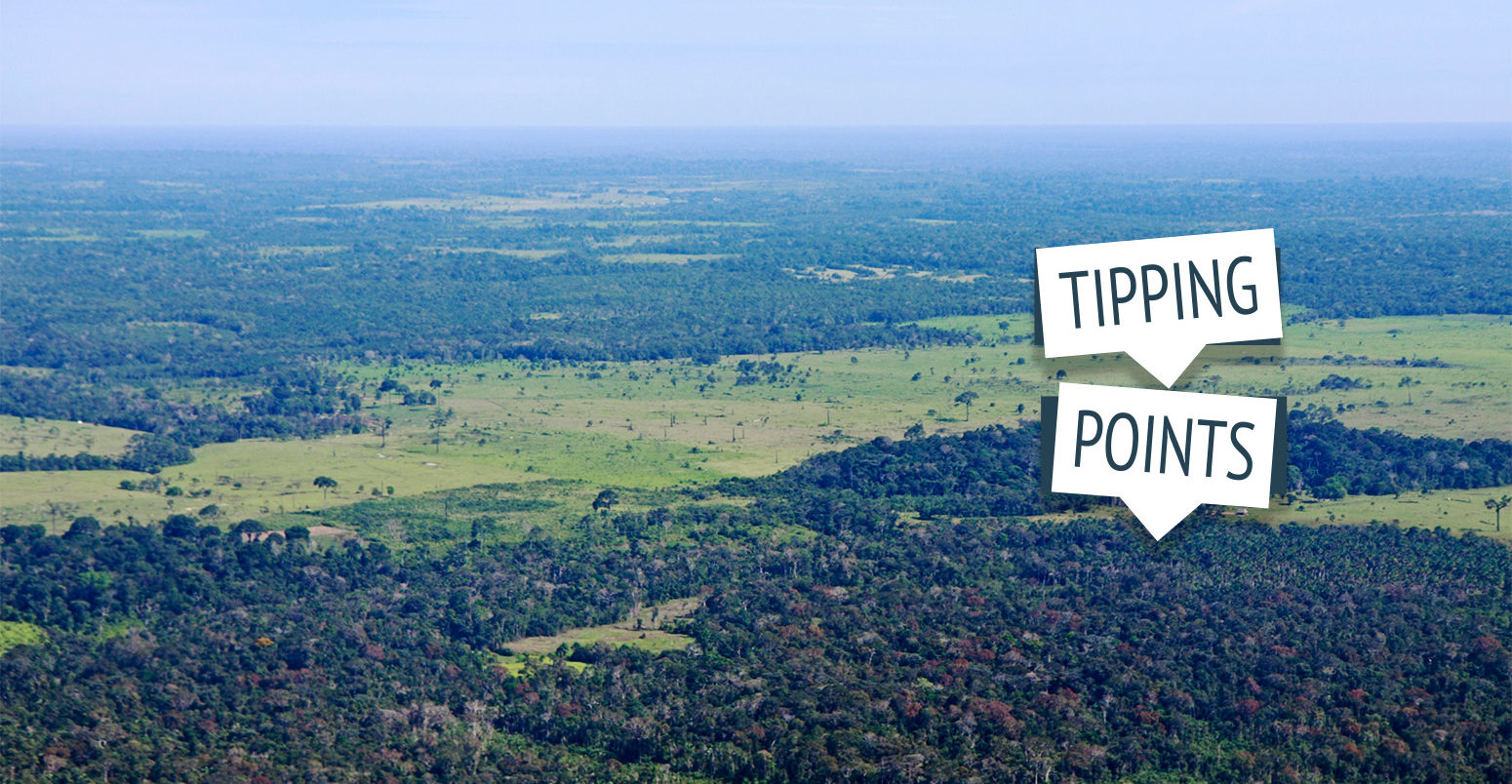
Guest post: Could climate change and deforestation spark Amazon ‘dieback’?

Prof Peter Cox
02.13.20
Prof Peter Cox
13.02.2020 | 8:00amLast summer, the Amazon rainforest was in the news again for all the wrong reasons. Deforestation rates are on the rise under the leadership of Brazilian President Jair Bolsonaro and 2019 brought the highest number of forest fires in almost a decade.
For the global climate, this is a cause for concern. The Amazon plays a vital role in the climate system, recycling water to help sustain rainfall in the region and drive atmospheric circulations in the tropics. In addition, destroying the forest would have a major impact on atmospheric CO2.
- Explainer: Nine ‘tipping points’ that could be triggered by climate change
- Guest post: Could the Atlantic Overturning Circulation ‘shut down’?
- Guest post: The irreversible emissions of a permafrost ‘tipping point’
- Guest post: Could climate change and deforestation spark Amazon ‘dieback’?
- Guest post: How close is the West Antarctic ice sheet to a ‘tipping point’?
It is estimated that the remaining intact Amazon rainforest currently absorbs 5-10% of human CO2 emissions, helping to slow climate change. Deforestation removes this sink of carbon and replaces it with a source, which would make the already challenging Paris climate targets impossible.
There are many legitimate reasons to argue for greater protection of the Amazon rainforest. But even if the rate of direct human-deforestation slows again, could the forest disappear because of climate change?
Climate change-induced Amazon forest dieback
The recent Amazon fires have sparked claims that burning of the rainforest will have a significant impact on the amount of oxygen in the air that we breathe.
This is one aspect of Amazon destruction that we need not worry about. The Amazon rainforest contains about 15% of the total carbon stored worldwide in vegetation. If that 70bn tonnes of carbon was released, it would combine with oxygen in the air and be released largely as CO2. But because oxygen makes up as much as 21% of our atmosphere, this would only reduce the oxygen concentration by less than 0.01%.
However, there are much more pressing reasons to be worried about the destruction of the Amazon rainforest – not least that it has been touted as a possible climate tipping point.
This is due in part to the climate model simulations carried-out by my research group at the Met Office Hadley Centre for Climate Prediction and Research in the late 1990s and early 2000s. We included a representation of how vegetation types might shift in response to climate change and how this could feedback to affect the rate of climate change.
Alarmingly, our first coupled model projections saw the predicted Amazon forest “dieback” under climate change – even though we had not included direct human-caused deforestation and fires in our simulations.
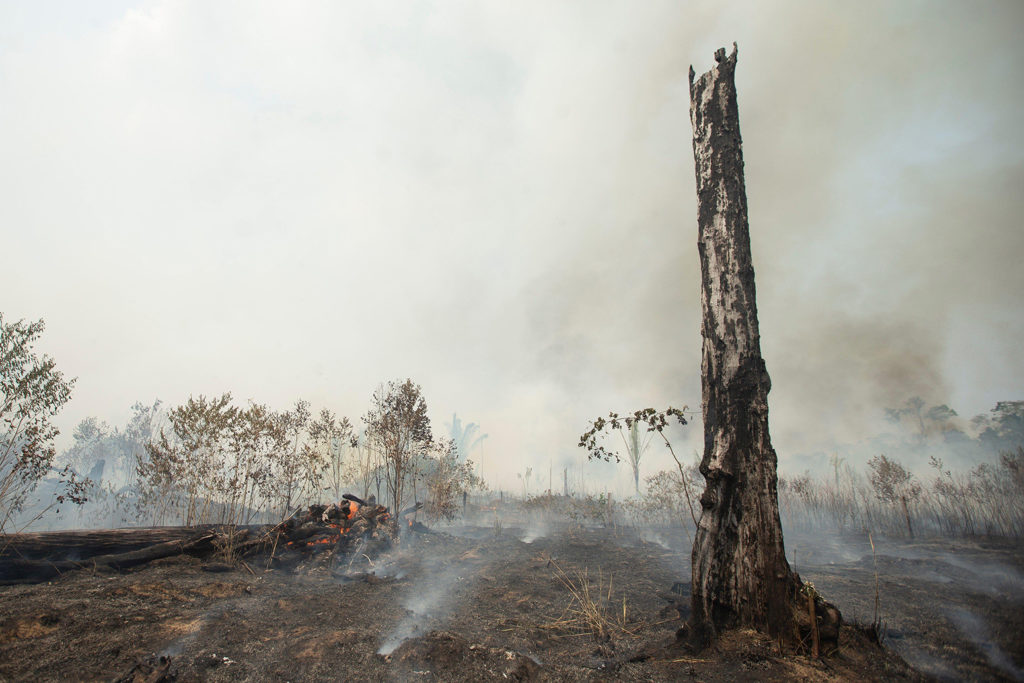
This modelling outcome was stark, but it turned out to be the result of a subtle interplay of different feedback mechanisms.
First and foremost, our Amazon rainforest died because the climate model predicted severe warming and drying under a “business as usual” emissions scenario called “IS92a”. That reduced the extent of the forest that can be sustained in a changing climate. With less forest there was less efficient recycling of the diminishing rainfall in the region, which led to further warming and drying, and further reduction in forest area.
But it was not as simple as that. As the climate change was being driven largely by increases in CO2, there were also counteracting direct effects of CO2 on the forests.
Higher levels of CO2 in the atmosphere have a “fertilisation” effect on plants and trees, boosting photosynthesis and promoting growth. Under elevated CO2, plants also tend to use water more efficiently, such that they need less water for a given amount of photosynthesis.
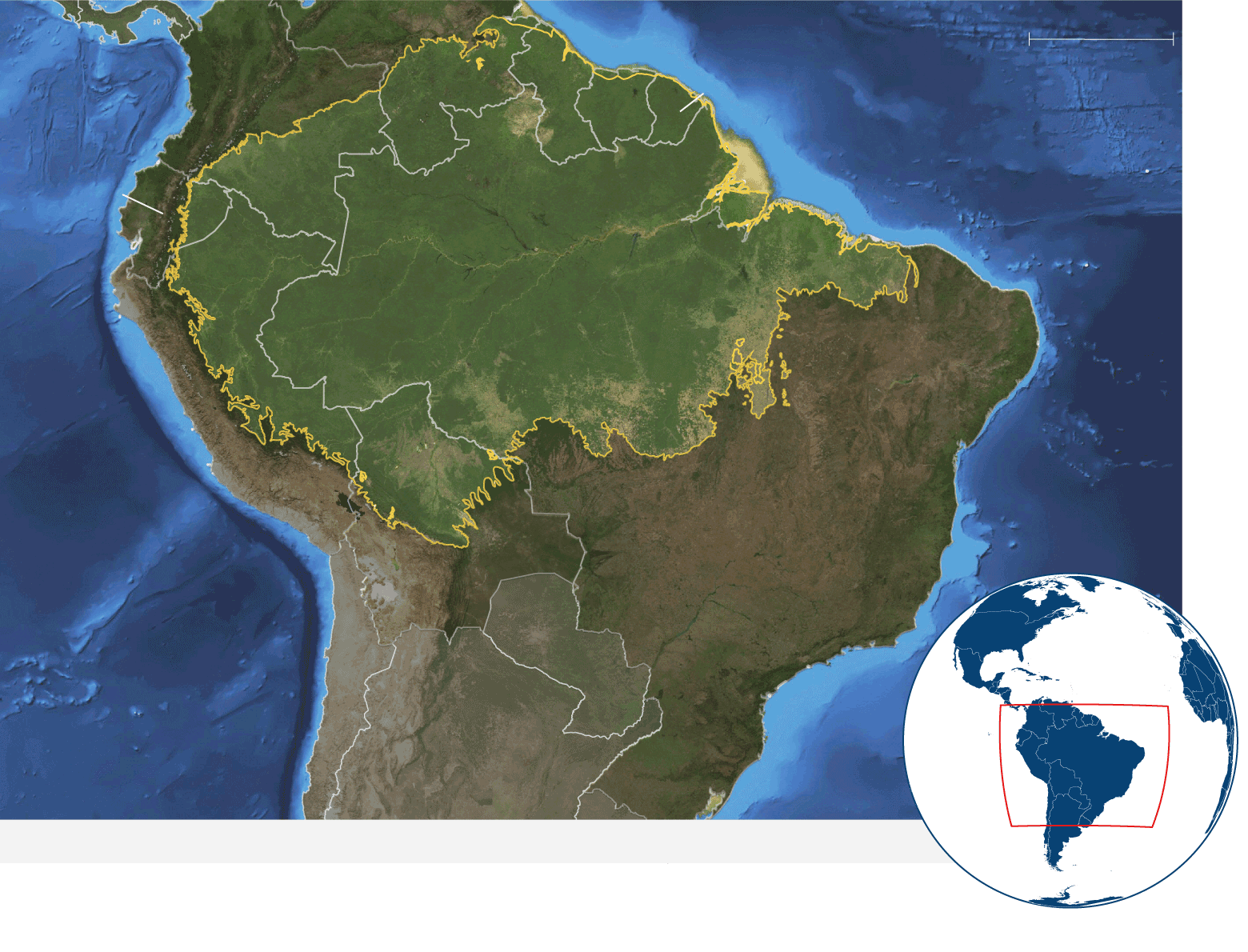
Venezuela
1,000 km
Guyana
French Guiana
Colombia
Suriname
Ecuador
AMAZON RAINFOREST
Peru
Brazil
Bolivia
Paraguay
Chile
Argentina
Graphic: Carbon Brief. Credit: Ecoregions/Resolve. © Esri
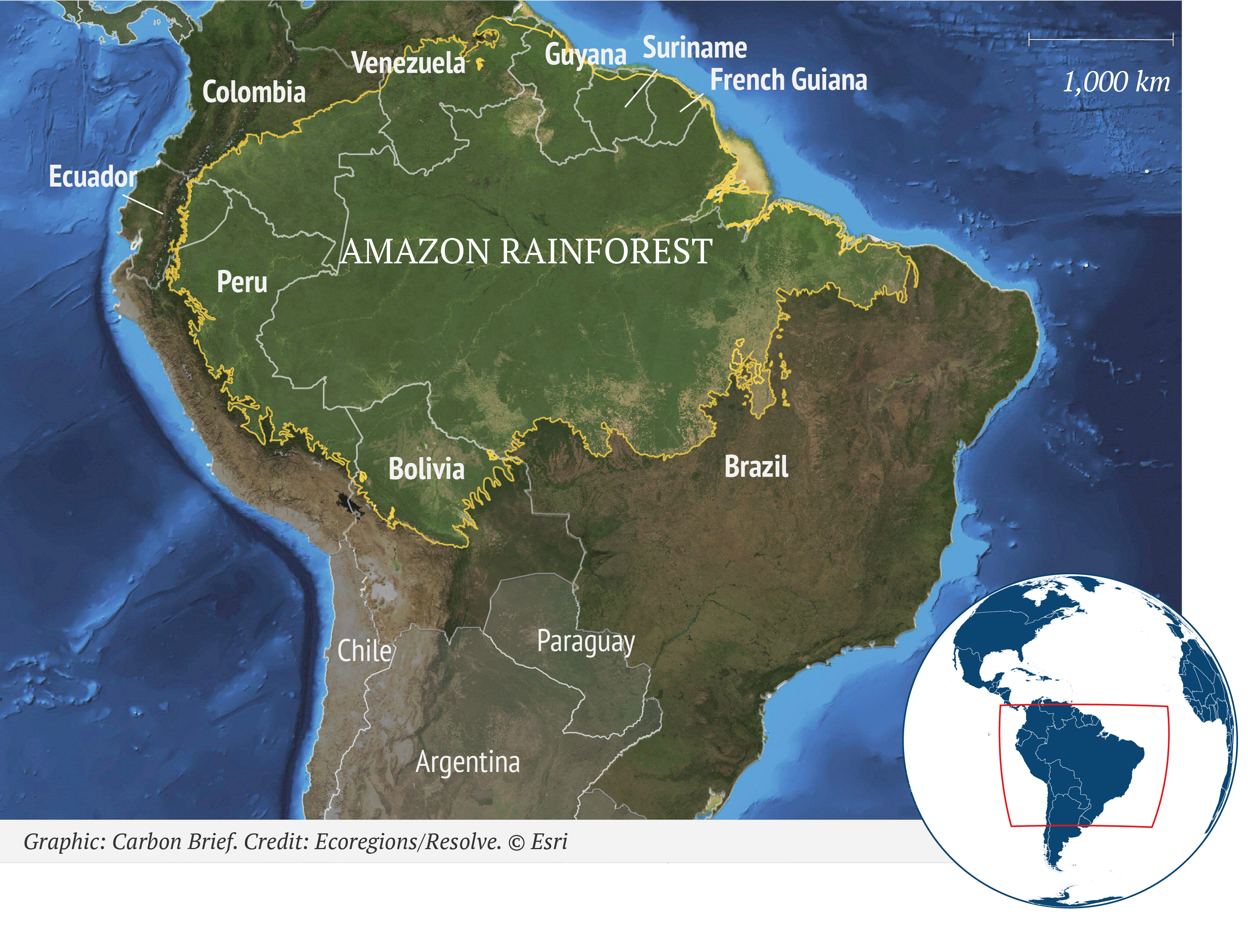
Where there is adequate soil water and nutrients, this effect manifests itself as increased carbon uptake by a forest. However, where there is a limited supply of water, the increased efficiency will manifest itself as reduced evapotranspiration from trees. This provides protection from reductions in rainfall, but at the cost of causing further increases in local surface temperature as a result of reduced evaporative cooling.
In our model, the evolution of the Amazon rainforest was at the mercy of this competition between the largely negative impacts of climate change and the largely positive impacts of increasing CO2.
Our model suggested that the CO2 effects had dominated over the 20th century – leading to a carbon sink in the intact rainforest. However, the model had the negative climate effects eventually winning out – resulting in an abrupt dieback of the Amazon rainforest from about 2040 onwards, when global warming had reached about 3C in this projection.
You can see this in the chart below, which shows how our model projected vegetation in the Amazon could change as the climate warmed through to 2100. It shows an Amazon dominated by trees (solid line) for decades, but then the fraction of the region that is covered by trees drops off dramatically through the middle of the 21st century. It is then replaced with grasses (dashed lines) and bare soil (dashed and dotted line).
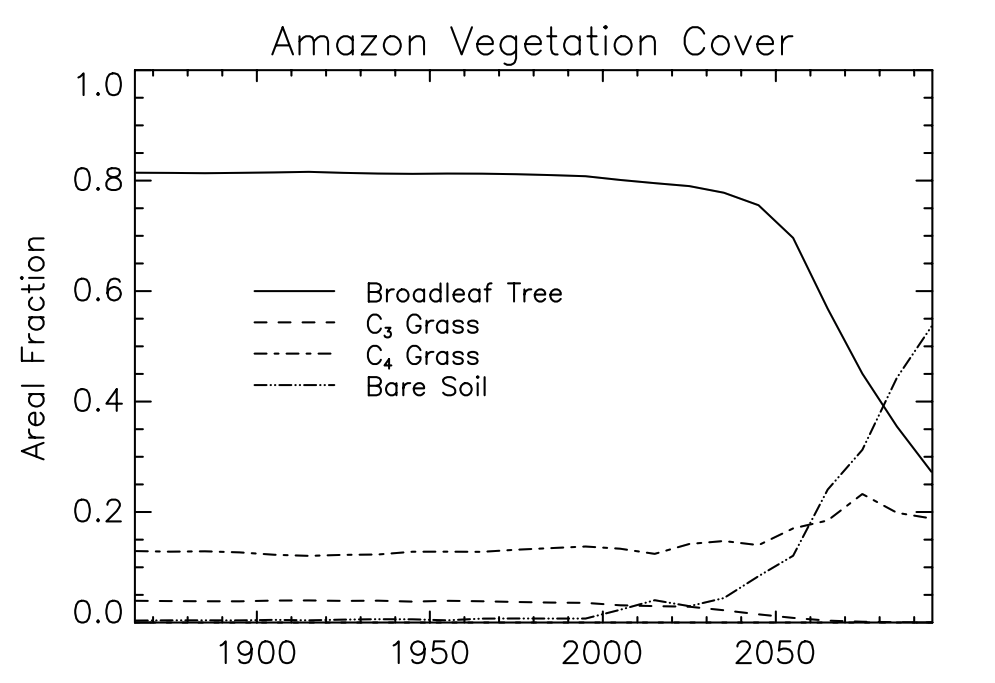
Good and bad news
Our findings were stark. However, recent research hints that Amazon forest may be more resilient to climate change. A lot of relevant research has flowed under the bridge since we published that dieback scenario in 2000 – some good news and some bad news for the forest.
First, the good news. It now seems that climate change is unlikely to be as damaging to the Amazon rainforest as we originally feared. In 2013, we discovered that the year-to-year variation in the annual increase in atmospheric CO2 allows us to estimate the sensitivity of tropical carbon sinks to climate change.
Global CO2 concentration has been increasing year-on-year due to increasing CO2 emissions from human activities, most notably fossil fuel burning, deforestation and cement production. But if you take out that long-term trend you find a variation in the CO2 growth-rate that correlates well with the climate variations in the tropics associated with the El Niño-Southern Oscillation. This signal, therefore, shows us something about how sensitive tropical land carbon is to climate variations.
We can use an ensemble of climate-carbon cycle models to relate this short-term sensitivity to the longer-term sensitivity of tropical ecosystems to climate change – to create a so-called “emergent constraint”. The across-model relationship allows us to convert an observation of the variation in the CO2-growth-rate in the real world, into an improved estimate of the sensitivity of tropical land carbon to future climate change.
The resulting emergent constraint on the sensitivity of tropical land carbon to global warming indicates a negative impact, with warming alone leading to carbon loss of about 50bn tonnes of carbon per degree of global warming in the tropics. However, the magnitude of the effect is about a third as large as seen in our original Amazon dieback projection.
But there is also some less optimistic news. It now also seems that the CO2-fertilisation effect is unlikely to be as large as many early models assumed. This is because first and second generation climate-carbon cycle models did not include nutrient limitations on forest growth.
In the real world, the growth of vegetation is often limited not just by water and CO2, but by nutrients. In most regions the key limiting nutrient is nitrogen, but in tropical forests phosphorus or other micronutrients limit tree growth. These nutrient limitations will cap the CO2 fertilisation of plant growth, most likely below that seen in early climate-carbon cycle models.
This would leave tropical forest more vulnerable to the negative impacts of climate change than our original dieback scenario, even though those climate effects may themselves be less negative than originally feared.
So what’s the overall prognosis for climate change driven Amazon dieback?
The latest Earth system models show limited evidence of Amazon forest dieback in the absence of direct human deforestation. A handful of models show reductions in Amazonian forest cover due to climate change, but most models show increasing forest cover due to CO2 fertilisation.
None of these models include phosphorus limitations or forest fires, though, so the jury is still out. However, personally, I am less concerned about climate-change driven Amazon dieback than I was when we published our study in 2000.
Greater reason to be concerned about direct human deforestation
Rather ironically, this makes me more concerned about increasing rates of deliberate deforestation in Amazonia. It might even be argued that there is less value in conserving a forest if that forest will subsequently be damaged by climate change. On the contrary, greater resilience of the Amazon rainforest to climate change provides additional reasons to save it for the future.

The Amazon rainforest sustains its own climate by recycling water to the atmosphere, which maintains rainfall and reduces the length of dry seasons. Deforestation undermines those regulatory mechanisms and may, ultimately, lead to a tipping point.
This, in combination with the dry season becoming long enough to permit regular natural fires, could see the forest transition to a permanent savannah. This would be characterised by a mixed tree and grassland system with an open canopy that allows the soil to become much hotter and drier, as well as store much less carbon.
Therefore, the twin pressures of deforestation and climate change on the Amazon rainforest remain a great concern. We are unlikely to know the vulnerability of the rainforest to climate change with any confidence until it is too late. However, we are sure that human-caused deforestation reduces the resilience of the forest to climate change and other stressors.
Many had thought the problem of Amazonian deforestation was on the path to being solved. The rate of deforestation dropped from a peak in 2004 of 28,000 square kilometres (km2) – equivalent to removing an area of forest almost the size of Belgium each year – to less than a fifth of that rate by 2014.
But that is all in the past now. With deforestation on the up and global warming continuing, there are, once again, multiple threats to the longevity of the Amazon rainforest.
-
Guest post: Could climate change and deforestation spark Amazon ‘dieback’?

